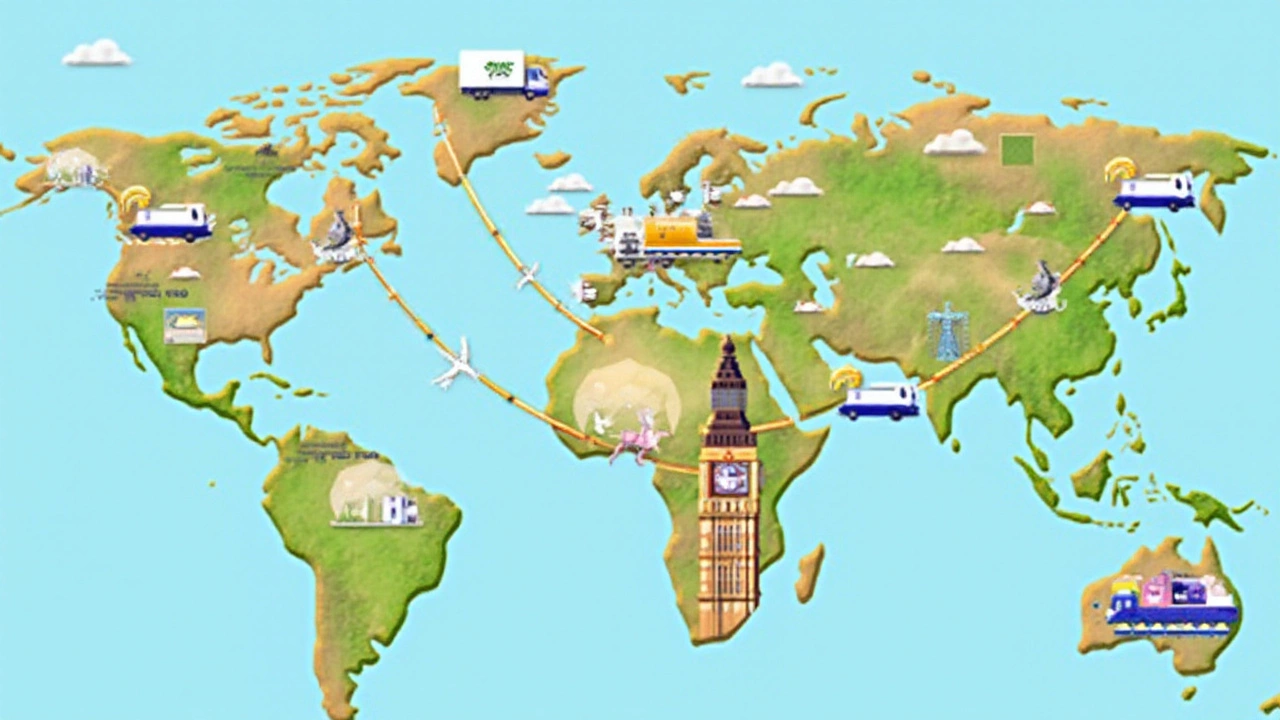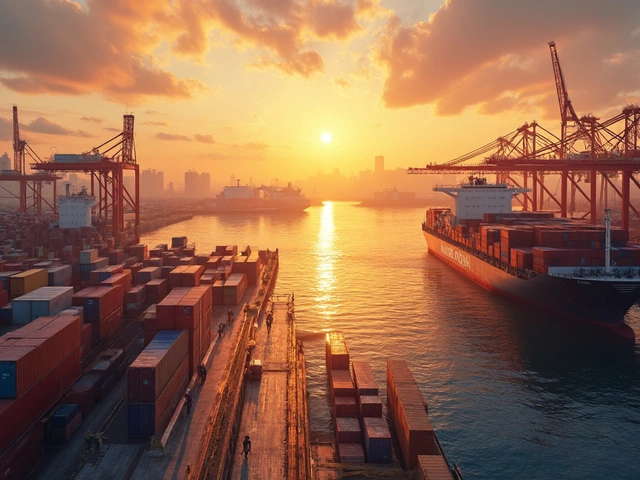Sending a package across international borders can sometimes feel like navigating a financial minefield. With so many shipping options and price points, finding an affordable solution might seem overwhelming. But worry not, this guide is here to help.
Discovering the cheapest way to ship a package overseas starts with understanding your shipping options. Whether you're sending gifts to loved ones or fulfilling an online sale, there are ways to keep storage affordable and avoid surprises when the bill arrives.
By making smart choices about services and packing method, you can minimize costs and ensure your package reaches its destination safely and on time. So, let’s dive into some of the best strategies for frugal yet efficient international shipping.
- Understanding Shipping Options
- Comparing Costs and Services
- Tips for Cost-Effective Packing
- Avoiding Hidden Fees
Understanding Shipping Options
When shipping a package internationally, it’s important to familiarize yourself with the myriad options available, each suitable for different needs and budgets. The key to choosing the right method lies in understanding the trade-offs between cost, speed, and reliability. Major carriers like DHL, FedEx, and UPS offer comprehensive services for shipping worldwide. These carriers are known for their reliability and speed, ensuring that packages not only arrive on time but often sooner than expected. However, with great service comes significant cost, and this is where the balancing act begins.
Traditional mail services like USPS, Royal Mail, or Australia Post can be more economical for smaller, less time-sensitive packages. They offer basic shipping at lower rates, albeit with longer delivery times. The trade-off here is less predictability about delivery time and potentially less detailed tracking information. On the other hand, courier services often provide door-to-door tracking and expedited delivery options. While such options can seem costly upfront, especially for small packages, they often prove their value in urgent or delicate shipments.
Meanwhile, specific services often cater to niche shipping requirements. For instance, economy services by major couriers are a popular choice for cost-conscious individuals or small businesses that prioritize savings over speed. Many individuals are unaware that using online shipping platforms like Packlink or Shippo can help uncover hidden discounts with reputed carriers, as these platforms aggregate rates across different services, providing easy comparisons and transparent pricing. It's also worth exploring partnerships with logistics companies if you're sending larger volumes as they frequently offer reduced rates for sustained business.
Customs regulations and duties also play a significant role in the decision-making process. It's crucial to understand the restrictions and costs associated with sending goods to specific countries. Some destinations impose heavy duties or taxes, which might significantly impact the total shipping cost. The good news is that many courier services offer tools and calculators on their websites to help you estimate these additional charges upfront. According to a survey by Shipping and Freight Resource, 65% of businesses reported unexpected international shipping costs as a primary pain point.
To fully appreciate the best compromise between these varied options, consider factors such as package weight, size, destination, and the urgency of delivery. It's advisable to conduct a cost-benefit analysis weighing these elements to identify what suits your needs best. Additionally, staying informed about the seasonal surcharges and potential service disruptions during peak periods can help in planning shipping in advance, often saving both money and hassle. As the shipping landscape continues to evolve with technology and demand, staying updated ensures you always have competitive, efficient options at your disposal.

Comparing Costs and Services
Understanding the expenses involved in shipping packages internationally can unlock the optimal method tailored for your budget and needs. The landscape of international package delivery is vast, with numerous courier companies offering distinct services, timelines, and pricing structures. When comparing options, the initial step is researching the most prominent players like DHL, FedEx, UPS, and even postal services like USPS or New Zealand Post. Each of these carriers has a unique formula for calculating shipping costs – factors such as package weight, dimensions, travel distance, and delivery speed can alter the price tag significantly. Notably, some services offer flat rate boxes that could be ideal for sending heavy items at a predictable cost, eliminating variable costs based on weight or location.
Another crucial element in the cost comparison is timing. While express deliveries promise speed, this convenience often comes at a premium. On the other hand, standard or economy services, although slower, can considerably reduce expenses. For example, a package sent from New Zealand to the United States might cost an arm and a leg for overnight delivery, whereas opting for a slower 10-14 days service might slay the price by more than half. Don’t forget the influence of seasonal changes; shipping cost can be unpredictable around holidays or peak seasons due to fluctuations in demand and fuel surcharges.
Shipping services sometimes introduce hidden fees such as customs clearance charges or fuel surcharges, which can surprise you on the final invoice. You can circumvent these costs by selecting 'customs duties paid' services. A practical approach is asking for a complete breakdown from the service provider before dispatch. It is wise to note the potential for savings by aggregating smaller packages into a larger consignment if possible – this reduces per-unit cost, making shipping more economical. Bartering loyalties for discounts is another savvy technique; some services offer reduced rates for businesses or frequent shippers.
"The money saved from choosing standard shipping over express can often be used to insure your package, providing peace of mind that it will arrive safely," says logistics expert Carolyn Hunter. This approach reaffirms that balancing cost and security doesn't mean compromising one for the other.
In the age of digital information, leveraging online comparison tools has become indispensable for making informed decisions. Websites like ParcelMonkey or Shiply provide users with real-time pricing comparisons across multiple service providers. Such resources consider package specifics and chosen delivery windows to present the best deals. Moreover, some of these platforms offer additional discounts or valuable perks like package tracking, enhancing the overall experience.

Tips for Cost-Effective Packing
Packing might seem like a straightforward task, but when it comes to international shipping, every detail counts towards achieving the most cost-effective solution. First and foremost, understanding the dimensional weight (DIM) pricing model adopted by most shipping companies is crucial. The DIM weight is calculated by the size of the package rather than the actual weight, meaning a lighter but bulkier package might cost more to ship. So, aim to keep your package as compact as possible without sacrificing the safety of the contents.
Begin by selecting the right-sized box. Using a box that fits snugly around its contents without much extra space not only reduces the volume but also lessens the need for costly additional packaging fillers. Newspaper or reused bubble wrap can fill any gaps, providing that extra protection without added expense. It's also worth exploring what's on hand before buying; many homes and businesses have packaging supplies that are more than adequate.
Packing materials themselves can also tip the scale. It is best to avoid over-the-top, heavy materials when lighter options exist. Materials like corrugated cardboard are both lightweight and sturdy enough for most shipments. Reflecting on designing best-practice packaging, The International Union for Conservation of Nature advises simplicity as a key consideration to optimize shipping costs effectively. Simple adjustments in packaging, such as using thinner padding while ensuring protection, can help save on costs dramatically.
"Good packaging is as much about reducing weight as it is about protecting the contents. A balance between secure and streamlined can be achieved if efforts are focused on packaging design." - Packaging Industry Expert
For those shipping frequently or in bulk, investing in a scale to weigh packages at home can help ensure you're not overpaying. Knowing the exact weight before dropping it off lets you take full advantage of savings before reaching the checkout counter. This tool also prevents surprises with shipping costs due to miscalculated weight estimations.
Labeling effectively is another key point. Always double-check the accuracy of addresses and labels. Improper labels not only cause delays but can result in return shipments at the sender's expense. Having a clear, accurate label upfront can prevent unwanted headaches and costs.
Cost-Benefit of Flat-Rate Boxes
An increasingly popular choice among shippers is the use of flat-rate boxes. These provide a cost-effective way to ship internationally without worrying about the dimensions of your package. If what you’re sending fits in the box, it's easy to calculate the shipping cost. With these kinds of boxes, weight and distance often don't factor into pricing, which can lead to substantial savings.
- Remember to compare the size and weight of various flat-rate options to ensure you’re opting for the best fit for your needs.
- Review carrier restrictions for flat-rate boxes, particularly when sending to certain countries.
Hopefully, these shipping tips provide you with a foundation to start saving costs on sending packages abroad. With a few thoughtful considerations and adjustments, shipping internationally can be both economical and efficient.

Avoiding Hidden Fees
Let's delve into the maze of international shipping and uncover the mystery behind hidden fees. These sneaky charges can creep up on you, turning what seemed like a good deal into a much costlier proposition. To protect yourself from unexpected costs, it’s necessary to first understand what these hidden fees include. Customs duties, taxes, and handling fees are a few that often catch people off guard. Many countries impose varying levels of duties on items depending on their type and value, so knowing the rules beforehand can save both money and frustration.
An often-overlooked fee is the shipping surcharge related to package weight and dimensions. Think back to the last time you sent a bulky package and were surprised by an additional charge. Shipping companies might state a base fee, but additional costs escalate rapidly when standard sizes or weights are exceeded. A simple solution involves double-checking your package dimensions after packing—remember, even a few centimeters can make a difference. Measuring your parcel correctly ensures you're not hit with unexpected costs at the shipping counter.
Currency conversion fees might not be obvious at first, yet they add up quickly when transferring funds across borders. Depending on your shipping provider, these rates vary and are rarely transparent. To find the best deal, shop around to compare the conversion rates offered. Even small differences in these rates can equate to significant savings when sending multiple international packages. For managing currency exchanges, consider using apps that provide real-time comparisons.
Hidden charges in international shipping are like potholes on a map to savings, noted John Strader, a logistics analyst who specializes in global commerce. Navigating them requires awareness and strategic planning.
One might also consider the destination’s unique requirements, as certain locations impose fees for specialized services such as remote area delivery. If your package is bound for a less accessible region, additional handling costs could arise. Speak with the courier service in advance to anticipate such fees. Often, such interactions reveal discount opportunities that can mitigate these costs considerably.
Finally, packaging materials can contribute to hidden expenses too. While it may seem trivial, packing with heavy materials or excessive cushioning might incur extra charges, especially if it impacts the parcel's weight. Adopting alternative packing methods, such as using lightweight and compact materials, could conserve space and reduce costs. Disassembling items and efficiently arranging them within the package ensures the dimensions stay compact and manageable.





